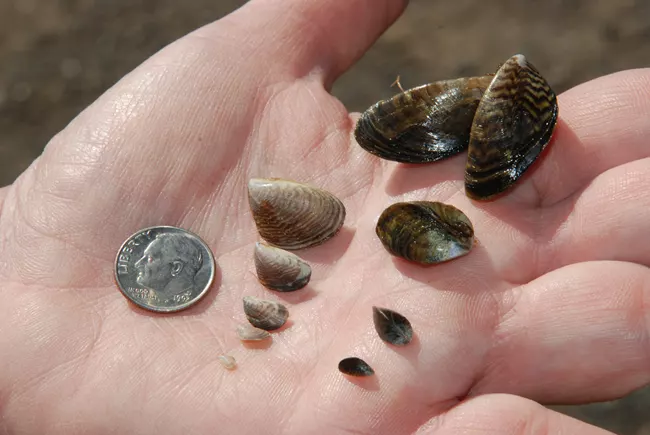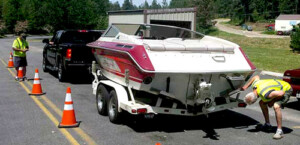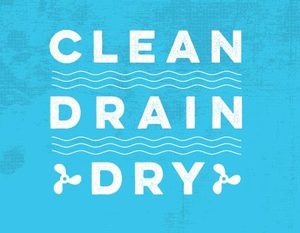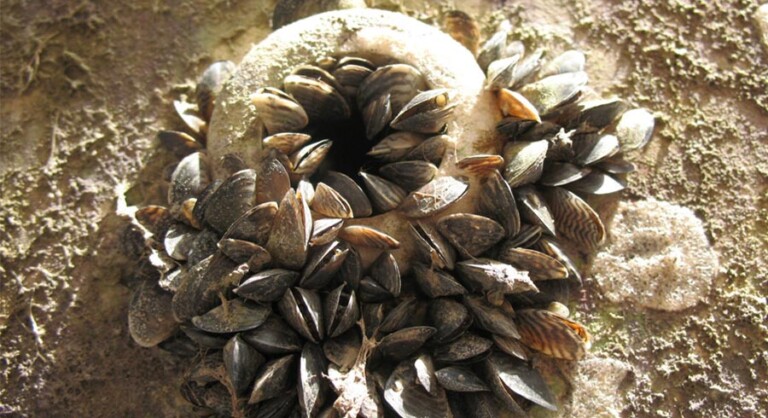
What is a quagga mussel?(3)
- Quagga mussels are a more aggressive cousin to the invasive zebra mussel, both in the Dreissenidae family.
- Like their zebra cousins, they are small, triangular, freshwater bivalves with rounded, asymmetrical shells. They usually grow to about the size of a quarter.
- They are blond to black in color, sometimes with varying stripes.
- They can affix to hard surfaces like docks and dams and soft surfaces like sandy lake bottoms.
- They produce millions of eggs in a spawning season, to the point of outcompeting native plants and animals for resources.
The alarm has sounded!
Idaho State Department of Agriculture (ISDA) has identified veligers, the free-swimming larval stage of the invasive quagga mussel, in the waters of the Snake River near Twin Falls. They have shut down the suspect part of the river and, for the first time, are carrying out a rapid response protocol. Their efforts aim to identify the scope of the infestation, manage the impact, and prevent the spread of this invasive muscle.
What does it mean for Hayden Lake?
This alarming news raises many questions about Hayden Lake’s vulnerability to invasive muscles, ranging from “Are they here?” to “Are they really that bad?” Here are some answers. More will come in the following days.

ISDA tests Hayden Lake for the presence of invasive mussels every two weeks. Neither adult quagga mussels nor their larval stage veligers have been found in Hayden Lake.
Though Hayden Lake offers a variable and seasonally harsh habitat for aquatic life, these invasive species would have little trouble making themselves at home in our lake:
- Hayden Lake’s fresh water is just what these mussels need. They can handle up to about 4 ppt salinity, 100x the average salinity of Hayden waters.
- Though Hayden Lake’s water temps dive below 42 degrees F in the winter, quagga mussels survive in very cold, warm, and even stagnant water. Zebra mussels are only slightly less temperature tolerant. (1).
- Calcium is required for shell and gamete production, and Hayden Lake’s average calcium concentration of 8 mg/L (1) is just enough to support juvenile growth.
- pH also plays an important role in quagga mussel growth. Hayden Lake’s average pH of 7.7-8.7, depending on location (2), is well within the support range.
 For Hayden Lake, recreational boating is the number one means of bringing mussels into our water.
Oregon State University’s 2011 study of the Columbia River Basin (1) rated the risk of mussel introduction to Hayden Lake as medium to high. This evaluation was based on the total day-use of the lake, the presence of boat ramps and marinas, water access, motorized boating, fishing, and angling competitions. Since 2011, recreational water use has increased, further raising the risk of mussel introduction.
For Hayden Lake, recreational boating is the number one means of bringing mussels into our water.
Oregon State University’s 2011 study of the Columbia River Basin (1) rated the risk of mussel introduction to Hayden Lake as medium to high. This evaluation was based on the total day-use of the lake, the presence of boat ramps and marinas, water access, motorized boating, fishing, and angling competitions. Since 2011, recreational water use has increased, further raising the risk of mussel introduction.

- CLEAN, DRAIN, DRY ALL WATERCRAFT – This situation is a reminder to ANYONE who has a boat, kayak, canoe, paddleboard, or other conveyance to be prudent in performing the steps of CLEAN, DRAIN, DRY before putting your vessel back in the water. Yes, this is the most effective action you can take to prevent the introduction of invasive mussels to Hayden Lake.
- If your watercraft (including kayaks, canoes, paddleboards, boats, trailers, and any other items that come in contact with the water), now located in the Hayden Lake area, has been on the Snake River in the Centennial Park area of Twin Falls in the past 30 days, please call (208) 332 – 8620 for hotwash station location information or visit ISDA’s incident webpage.
- Stay out – If you are planning a trip to the Twin Falls area, please be aware that all boat ramps and public water access points from Twin Falls to Niagara Springs are closed until further notice as the investigation continues. The cooperation of the public in staying out of the affected area is crucial to the success of ISDA’s efforts.
Invasive mussels could have huge impacts on Hayden Lake.
Potential direct impacts include sharp mussel shells coating sandy shores, docks, and piers. Furthermore, secondary impacts, like increases in the cost of upkeep for private water intakes and Irrigation District water delivery, could be staggering.



